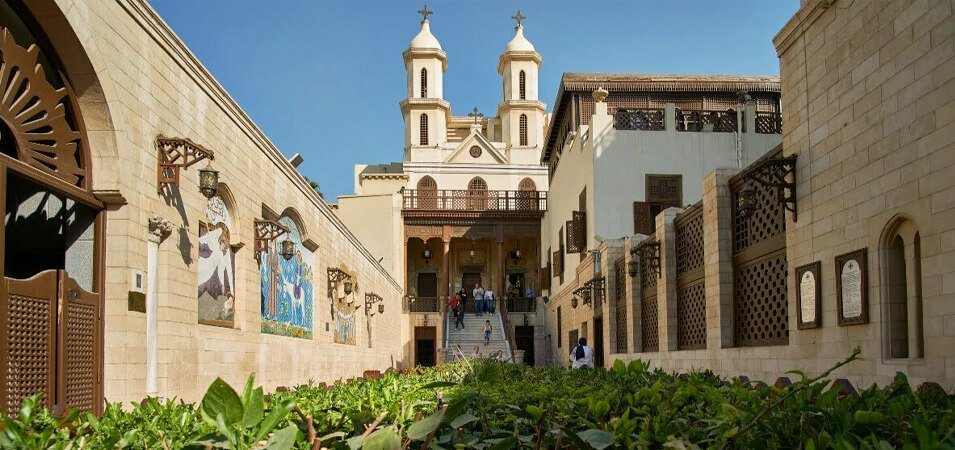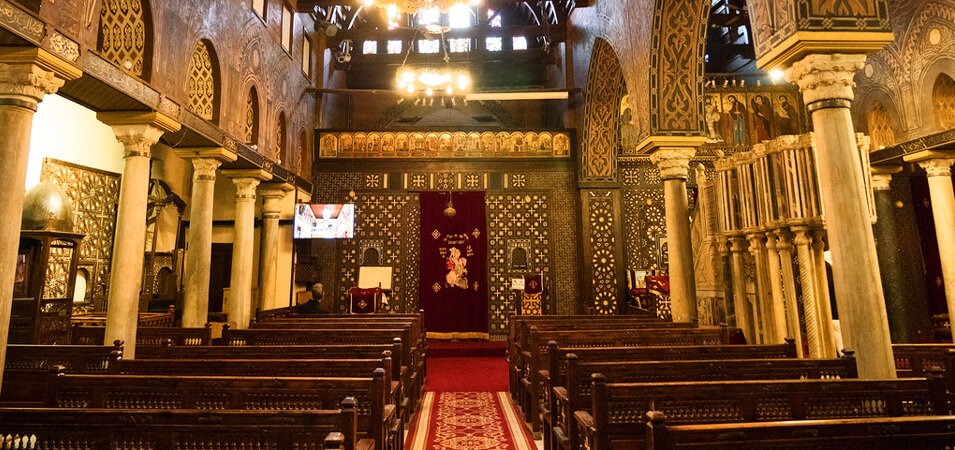The Hanging Church, or Saint Virgin Mary’s Coptic Orthodox Hanging Church, is one of Cairo’s most iconic religious sites. Located in Old Cairo, it holds great historical and cultural significance, representing the rich heritage of Coptic Christianity. Its unique architectural design, suspended above the ground, gives it the name “Hanging Church.”
Situated in Coptic Cairo, an area filled with ancient churches, synagogues, and Islamic landmarks, it attracts both religious pilgrims and history enthusiasts. With origins tracing back to the 3rd century AD, the church offers a fascinating glimpse into Cairo’s Christian past.
we will explore the church’s history, distinctive architecture, and cultural importance, providing a comprehensive look at one of Egypt’s most treasured landmarks. Whether you are a tourist or a history lover, this guide will deepen your appreciation for this remarkable site.
What is the Hanging Church?
The Hanging Church, or Al-Muallaqa in Arabic, is one of Cairo’s most historic landmarks. Its name comes from its unique position, built above the Roman Babylon Fortress, with its floor suspended over the fortress gates. This architectural marvel is a key symbol of Coptic Christianity in Egypt.
Al-Muallaqa translates to “the suspended one,” reflecting its elevated design. As one of the oldest Coptic Christian churches in Egypt, it holds great religious and historical significance.

Historical Significance
The church is believed to have been constructed between the 3rd and 5th centuries AD, making it one of Egypt’s oldest Christian sites. It is linked to key Coptic leaders and significant events in Christian history, having once served as the seat of the Coptic Orthodox Pope.
Over the centuries, the church has remained a symbol of the resilience of Egypt’s Christian community. Its lasting legacy continues as a place of worship and a cultural landmark, attracting pilgrims and visitors from around the world.
The Architecture and Design of the Hanging Church
Exterior Features
The Hanging Church stands elevated above the Roman Babylon Fortress, giving it a distinct and commanding presence. To reach the church, visitors cross a wooden bridge, which enhances its dramatic and elevated positioning. This bridge leads to a façade that blends Coptic and Roman architectural influences, symbolizing the church’s historical significance. The Roman influence can be seen in the use of columns and arches, elements that reflect the ancient heritage upon which the church was built. The exterior, though simple in some areas, is a reminder of the church’s enduring legacy and its connection to Egypt’s Christian roots.
Interior Splendor
- The Wooden Ceiling: The church’s wooden ceiling is a masterpiece, designed to resemble Noah’s Ark. Its intricate carvings and detailed craftsmanship evoke the biblical story of salvation, creating a spiritual atmosphere within the church.
- Iconostasis: The ornate iconostasis is another highlight of the interior. Made of ebony and ivory inlays, it serves as a partition between the nave and the sanctuary, adorned with religious icons that tell the story of Christianity.
- Famous Icons: Among the most revered icons in the church are those depicting the Virgin Mary and the Holy Family. These icons, painted with rich colors, are known for their vividness and emotional impact.
- Light and Space: The church’s design makes effective use of light and space to create a calm, reflective environment. The interplay of natural light filtering through windows enhances the serene atmosphere inside, allowing for quiet contemplation.
Restoration Efforts
Throughout its long history, the Hanging Church has undergone significant restoration efforts to preserve its beauty and historical value. Major projects have focused on restoring its wooden structures, the ornate iconostasis, and other key elements like the ceiling and frescoes. These efforts ensure the church remains a vital part of Egypt’s cultural and religious heritage, maintaining its authenticity while adapting to the needs of modern worshippers.
Religious and Cultural Importance
Role in the Coptic Christian Community
The Hanging Church has historically served as the seat of the Coptic Patriarchate, particularly during earlier centuries. It was once the residence of the Coptic Pope and played a central role in the administration of the Coptic Orthodox Church. Beyond its ecclesiastical function, the church has been a focal point for religious ceremonies and festivals. Major celebrations like Christmas and Easter are still observed here, drawing large crowds of worshippers. The church’s rich history and its connection to key figures in Coptic Christianity have solidified its status as a spiritual and cultural cornerstone for Egypt’s Christian community.
A Popular Pilgrimage Site
The Hanging Church attracts thousands of pilgrims each year, particularly during annual religious celebrations such as the Feast of the Assumption of Mary. This event, celebrated with much reverence, draws visitors from across Egypt and beyond. The church is also known for numerous stories of miracles, which have further enhanced its spiritual significance. Many believe that praying at the Hanging Church brings blessings and divine intervention. Its atmosphere of tranquility and divine presence continues to draw people seeking spiritual solace and connection.
Symbol of Religious Coexistence
Situated in Old Cairo, the Hanging Church stands in close proximity to key Jewish and Islamic landmarks, including the Ben Ezra Synagogue and the Mosque of Amr ibn al-As. This geographic closeness is symbolic of Egypt’s rich multicultural and multi-religious heritage. The church’s presence in this diverse area serves as a reminder of the centuries of peaceful coexistence among different religious communities in Egypt. The Hanging Church not only represents Coptic Christianity but also reflects the broader historical narrative of religious harmony in the region.

How to Visit the Hanging Church
Location and Accessibility
The Hanging Church is located in Old Cairo, a historic area known for its rich collection of religious sites. To reach the church, you can take a taxi or use public transportation. The nearest metro station is Mar Girgis on the Cairo Metro Line 1, which is just a short walk from the church. Alternatively, you can take a bus or tram that stops near Coptic Cairo. If you’re exploring the area, it’s best to access Old Cairo on foot, as the narrow streets and ancient landmarks are best experienced by walking.
What to Expect During Your Visit
When visiting the Hanging Church, there is no entry fee, but donations are welcomed to help maintain the church. The church is open to visitors daily, with visiting hours typically from 9:00 AM to 5:00 PM, though it’s advisable to check the exact schedule before your visit. As the Hanging Church is a place of active worship, visitors should be respectful and mindful of the religious nature of the site. Modest dress is encouraged, and visitors should maintain quiet during prayer times. Photography may be restricted in certain areas, so it’s best to ask beforehand.
Nearby Attractions to Explore
- The Coptic Museum: Just a short walk from the Hanging Church, the Coptic Museum houses a vast collection of artifacts that showcase the history and culture of Egypt’s Christian community. It’s a great way to learn more about the church’s historical context.
- Ben Ezra Synagogue: Located nearby, this historic synagogue is a significant Jewish landmark in Cairo. It dates back to the 9th century and is famous for its role in the history of Cairo’s Jewish community.
- Amr Ibn Al-As Mosque: As the first mosque built in Egypt, this site is an important part of Cairo’s Islamic heritage. It is located within a short distance from the Hanging Church and offers a glimpse into Egypt’s Islamic history.
These attractions, along with the Hanging Church, make Old Cairo a rich destination for those interested in exploring Egypt’s diverse religious and cultural heritage.
FAQs
Why is it called the Hanging Church?
The Hanging Church is named for its unique position above the Roman Babylon Fortress. Its floor is elevated, giving it a “hanging” appearance over the surrounding area, which has earned it this iconic name.
What is the best time to visit the Hanging Church?
The best time to visit is during the morning or early afternoon, when the church is less crowded and the light creates a peaceful atmosphere. Weekdays are ideal for avoiding the weekend crowds.
Is there an entry fee to visit the Hanging Church?
There is no entry fee, but donations are welcomed to support the church’s upkeep and preservation.
How long does it take to tour the Hanging Church?
A typical visit lasts about 30 minutes to an hour, depending on your interest in the architecture, history, and icons inside the church.
Can I take photographs inside the church?
Photography is allowed in certain areas of the church, but it’s best to ask for permission before taking photos, especially during services or in more sensitive areas.
Is the Hanging Church wheelchair accessible?
The Hanging Church has limited wheelchair accessibility due to its historical design, with steps leading up to the entrance and narrow pathways inside. It may be challenging for those with mobility issues.
Conclusion
The Hanging Church stands as a remarkable symbol of Egypt’s rich religious history, architectural grandeur, and cultural heritage. From its elevated position above the Roman Babylon Fortress to its stunning interior features like the wooden ceiling and intricate iconostasis, the church captivates visitors with its beauty and historical significance. As one of the oldest and most important sites for Coptic Christians, it continues to play a vital role in the spiritual life of Egypt.
Visiting the Hanging Church offers an opportunity to step back in time and immerse yourself in its serene atmosphere, where history, faith, and art converge. Whether you’re drawn to its architectural splendor or its spiritual presence, the church is a must-see destination in Cairo.
If you enjoyed learning about the Hanging Church, feel free to share this article or leave a comment with your thoughts and experiences. We’d love to hear from you!
